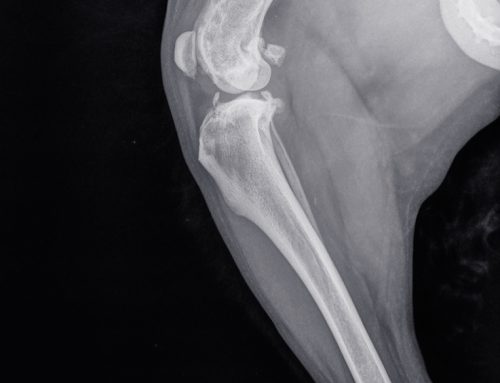Many people think it’s normal for a senior pet to have difficulty getting up, tire easily, and appear stiff when they walk. While senior pets do tend to move more slowly, it’s not always because of their age—it actually may be a sign of arthritis. Arthritis is a common condition in pets and can affect pets of all ages. Arthritis occurs when the cartilage that acts as a cushion between the bones in a joint becomes damaged. Over time this leads to inflammation and pain in the affected joints. Quite a few misconceptions about arthritis in pets exist, and our team at Scripps Ranch Veterinary Hospital has the facts you need to know about this degenerative joint disease.
Myth #1: There’s only one type of arthritis in pets
The most common type of arthritis in pets is osteoarthritis. Sometimes called degenerative joint disease (DJD), osteoarthritis results from long-term wear and tear on a joint. As the cartilage wears down, it causes joint inflammation and worsening pain. However, many other forms of arthritis also can affect pets, including:
- Rheumatoid arthritis — Rheumatoid arthritis is an autoimmune disease that occurs when a pet’s immune system starts to attack their body tissues, mistaking its own proteins for foreign proteins and damaging the joint lining and cartilage. Rheumatoid arthritis can be caused by a genetic predisposition or be a complication of other conditions, such as digestive diseases, cancer, or distemper.
- Septic arthritis — Septic arthritis is caused by a bacterial or fungal infection within the fluid of the affected joints and usually is caused by an injury, bite wound, or surgery.
Myth #2: Arthritis only affects older dogs
Age is a big factor in the development of arthritis, but younger pets can be affected by the condition as well. Other factors also can play a role in whether a pet develops arthritis, including:
- Developmental issues — Sometimes a pet’s joints develop improperly, which can result in hip dysplasia, elbow dysplasia, or luxating patella, and, ultimately, arthritis in the affected areas.
- Injury — An earlier fracture in the area of the joint or a previous rupture of the cranial cruciate ligament (CCL) in the knee can weaken the joint and lead to arthritis in the future.
- Obesity — Extra weight puts pressure on joints and damages cartilage.
Myth #3: It’s easy to diagnose arthritis in pets
While a person with arthritis can explain to their doctor that they experience pain when using a certain joint, pets don’t have this luxury. Pets tend to instinctively hide their discomfort until it becomes extreme and they begin to show the signs through their behavior. Subtle changes in your pet’s mobility or temperament can be indications they are in pain. Signs of arthritis may include:
- Mobility issues — A pet in pain may struggle to jump into the car, climb stairs, or stand up after lying down.
- Limping or lameness in hind legs — The limp likely will be more noticeable when your pet first stands up after lying down for an extended period.
- Hunched back — Arthritis can cause spinal issues and abnormal posture.
- Decreased energy — An arthritic pet may not be able to walk as far and may tire more quickly.
- Irritability — Because of the pain, a pet may not want to be in certain areas that cause discomfort.
- Licking or biting — A pet may lick or bite the sore areas, sometimes leading to skin inflammation and hair loss.
Myth #4: A pet with arthritis can’t exercise
Regular, low-impact exercise is important for pets with arthritis. Exercise helps keep their weight within a healthy range, preventing added pressure on the joints, and can be beneficial in managing pain by strengthening muscles and tendons.
Myth #5: A pet’s arthritis can be cured

Arthritis cannot be cured, but pain management treatments can help keep your pet comfortable. If your pet is diagnosed with arthritis, you can work with your veterinarian on the various treatment options available, including:
- Weight management
- Pain-relieving medications
- Joint supplements — These can reduce inflammation and support cartilage health.
- Surgery — Orthopedic surgery can repair or correct some conditions, such as a torn cranial cruciate ligament or hip dysplasia.
- Alternative therapies — Options such as physical therapy, hydrotherapy, acupuncture, and electromagnetic field therapy may provide your pet with some relief.
The best way to support a pet you suspect is suffering from arthritis pain is to consult with a veterinary professional who can provide a diagnosis and determine a multimodal treatment plan to keep them comfortable. Contact our team at Scripps Ranch Veterinary Hospital to schedule an appointment.





Leave A Comment